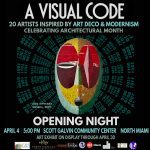From Wikipedia:
María Magdalena Campos-Pons (born July 22, 1959) is a Cuban-born artist based in Nashville, Tennessee. Campos-Pons works primarily in photography, performance, audiovisual media, and sculpture. She is considered a “key figure” among Cuban artists who found their voice in a post-revolutionary Cuba.[1] Her art deals with themes of Cuban culture, gender and sexuality, multicultural identity (Cuban, Chinese, and Nigerian) as well as interracial family (Cuban-American), and religion/spirituality (in particular, Roman Catholicism and Santería).[2]
Campos-Pons was born in Matanzas, Cuba, in 1959[3] and grew up in a sugar plantation town called La Vega in Cuba.[4] Her paternal great-grandparents were Nigerian (Yoruba). She also has Chinese and Hispanic heritage. Her African ancestors, who were brought over by sugar plantation owners in the late 19th century, passed-down traditions from Africa that influenced and became part of Campos-Pons’s art.[5] The African side of her family worked as slaves on sugar plantations and as domestic servants.[6] The Chinese side of her family worked as indentured servants in sugar mills.[7]
When she was young, Campos relates that during a trip to the National Cuban Museum of Fine Art, she distinctly felt that black Cubans were conspicuously missing from the art. She did not feel as though black Cubans were equally represented.[8]
Campos-Pons has described much of her art education as very traditional, rooted in drawing and sculpture.[8] She trained at the Escuela National de Arte in Havana between 1976 and 1979.[4] From 1980 to 1989, she attended Havana’s Instituto Superior de Arte (ISA).[4] The ISA allowed students to be exposed to international artistic movements and develop art that drew from Cuba’s unique “mixed traditions and cultures.”[1] Her ISA painting professor Antonio Vidal, a Cuban abstractionist, had a lasting impact on her work as a painter and she presented his work, along with her work with Neil Leonard at documenta 14 in Kassel, Germany. [9]
Campos-Pons conducted her post graduate studies at Massachusetts College of Art and Design in 1988.[3] While there, she created her first film that was scored by composer, saxophonist, Neil Leonard, whom she married in 1989. Before moving to Boston in 1991 to live with Leonard, she took a fellowship in Banff, Alberta.[4][10][9] Since 2017, she has lived in Nashville, Tennessee.[6]
Between 1986 and 1989 Campos-Pons was professor of Painting and Aesthetic at the Instituto Superior de Arte. She started exhibiting internationally in 1984.[11] In the late 1980s, her art work gained “international recognition” with her abstract paintings dealing with female sexuality.[4] Her work coincides with the rise of the New Cuban Art movement.[1] The New Cuban Art movement began as a reaction against the repressive aspects of the Cuban state and the introduction of conceptual art.[12] The movement was less focused on technical skill and more on creating an art that was genuinely Cuban.[12] A large part of this artistic movement was the introduction of Afro-Cuban presence, both as artists and within the art itself.[12] Humor and spirituality were major themes in New Cuban Art.[12] Her early work, often consisting of separate, shaped canvases, suggested fragmentation of the female self and referenced Afro-Cuban myths. She also explored reproductive rights and feminism through her art.[1] Campos Pons work often revolves around feminist ideologies. In an interview with Lynne Bell, she stated: “My work in Cuba looked at issues of sexuality, women’s place in society, and the representation of women in the history of art”.[13] Since there was not a larger feminism movement in Cuba, it was only through the expression of art through artists like Campos-Pon and others that feminism was kept in the spotlight and popular consciousness.[1]
In the 1990s, Campos-Pons explored her family’s ties to slavery and the Santería tradition carried over by her Yoruba family members. Santería is a spiritual practice which was developed by African slaves in Cuba by combining influences from Yoruba and Roman Catholic religious systems. Santería is often referred to as a “woman’s religion” as it is a religion shaped by women and practiced largely by women.[14] Maria Magdalena Campos Pons uses Santería as a theme in her art to identify her Nigerian ancestry and Cuban heritage. She explores the rituals and symbols of Santería in some of her work from this time period.[1] The Seven Powers Come by the Sea (1992) and The Seven Powers (1994) are installations that address slavery and make mention of various Yoruba gods and goddesses. During the 1990s sound became increasingly important in Campos-Pons’ work and Leonard created electronic sound for all of her videos and installations.[10] Sound for the installations often used Leonard’s music incorporating fragments of Campos-Pons voice and field recordings, often heard via speakers that surrounded visitors.[10]
After 1994, there was a shift in Campos-Pons’s work, and it became somewhat ethnographic.”[1] This work is largely autobiographical and has tended to examine her ancestors’ relationship with slavery and the sugar industry.[15] Campos-Pon’s work investigates “a felt history,” through the intersection of “non-spoken narratives” and “resilient culture”.[16] She started using large-format photographs which were often arranged into diptychs, triptychs or other configurations. These works are reminiscent of works by Lorna Simpson and Carrie Mae Weems.[1]
In the early 2000s, Campos-Pons returned to elements of abstraction and minimalism that were reminiscent of her early work, and admittedly influenced by her Cuban professor Antonio Vidal.
According to Campos-Pons’ artist statement, her work “renders elements of personal history and persona that have universal relevance…My subjects are my Afro-Cuban relatives as well as myself…The salient tie to familiar and cultural history vastly expands for me the range of photographic possibilities.”[16] Campos-Pon is interested in showing “crosscultural” and “crossgenerational” themes dealing with race and gender as “expressed in symbols of matriarchy and maternity.”[17] Campos-Pons says: “Of merging ideas, merging of ethnicities, merging of traditions… I am as much black, Cuban, woman, Chinese. I am this tapestry of all of that, and the responses to that could be very complicated and could include even anguish and pain.”[8] Other ideas that her work explores includes exile, immigration, memory and Cuba itself.[8]
Her art has been shown in scores of solo and group exhibitions, including solo shows at the Museum of Modern Art in New York City; the Venice Biennale; the Johannesburg Biennial; the First Liverpool Biennial; the Dakar Biennale in Senegal; and the Guangzhou Triennial in China.[18]Campos-Pons’s work is in the collections of the Smithsonian Institution, the Art Institute of Chicago, the National Gallery of Canada, the Victoria and Albert Museum, the Museum of Modern Art, The Museum of Fine Arts, the Miami Art Museum and the Fogg Art Museum.[19]
Campos-Pons currently teaches at Vanderbilt University, Nashville, Tennessee.



